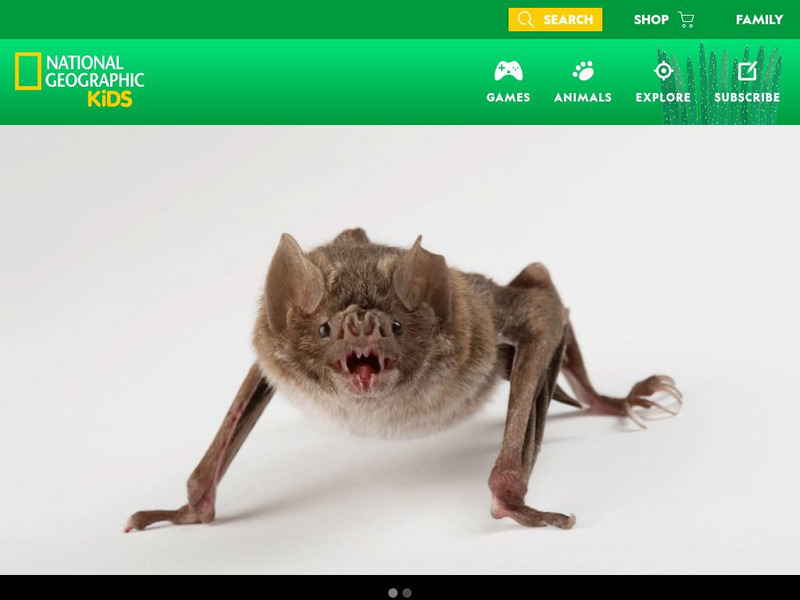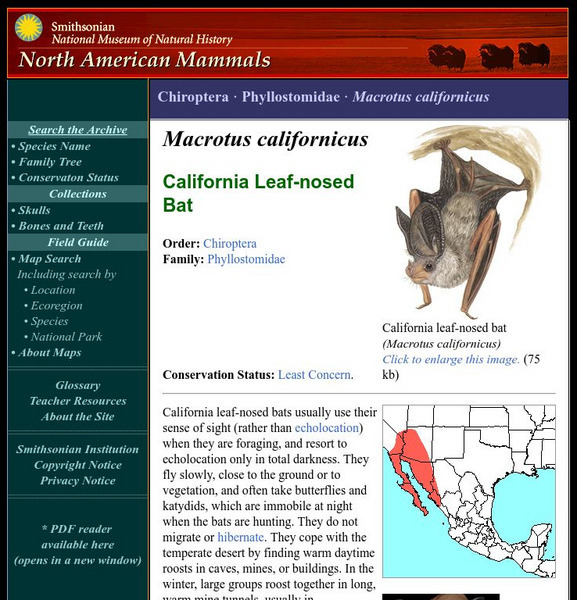Other
Bats4 Kids: Bats, Bats, Everywhere
Bat Conservation International has 24 biologists, educators, and administrators who are dedicated to their mission to further education, research, and conservation of bats. Dr. Merlin Tuttle and his staff have constructed Bats4Kids to...
Library of Congress
Loc: Everyday Mysteries: Why Do Bats Live in Caves?
Ever wonder why bats live in caves? Or why bats don't fly into objects at night? This article describe why bats thrive in the protected shelter a cave provides. It also explains how bats use echolocation to locate food and avoid obstacles.
Science Buddies
Science Buddies: Bat Detector: Listen to the Secret Sounds of Bats
Sometimes bats can "whoosh" right by you, and not be seen. In this science fair project, you will be able to detect flying bats by listening in on the ultrasonic signals they produce to locate objects in their environment. The bat...
Scientific American
Scientific American: A Field Guide to Bats : In Depth Reports
Uncover the evolutionary past of the mysterious bats. Find out about their amazing ability to use sonar, the threat of rabies they carry, and conservation efforts to save the species.
PBS
Pbs Teachers: Scientific American: Calls of the Wild: Bats and Echolocation
Explore bats' navigation systems by experimenting with echolocation. Approximate an object's distance by analyzing reflected sound waves, measuring the delay in sound and calculating the ratio to the speed of sound.
Read Works
Read Works: Bat News
[Free Registration/Login Required] This nonfiction passage describes the job of a chiroptologist, a bat scientist. This passage reinforces essential reading comprehension skills. Opportunities for vocabulary acquisition are also...
TeachEngineering
Teach Engineering: Biomimicry: Echolocation in Robotics
Students use ultrasonic sensors and LEGO MINDSTORMS NXT robots to emulate how bats use echolocation to detect obstacles. They measure the robot's reaction times as it senses objects at two distances and with different sensor threshold...
Unite for Literacy
Unite for Literacy: Mystic Aquarium: Bats Dare to Be Different
Read about bats' characteristics, habitat, diet, behavior, and their unique hearing ability called echolocation. You'll also learn why they are important to humans, the threats they face, and what you can do to help them. Includes audio...
Natural History Museum
Natural History Museum: The Secret Life of Bats: Bat Senses
Part of an online exhibit on bats, this section focuses on bat senses: sight, olfaction (smell), echolocation, and hearing.
Other
Contra Costa County Office of Education: Bats: Why Should You Care?
At this site, provided by the Contra Costa County Office of Education, you can get the facts on bats and their environment.
National Geographic Kids
National Geographic Kids: Animals: Vampire Bats
Great multi-media site from the National Geographic Society with great information, pictures and video of Vampire Bats. Sections include fun facts, video, audio, a map and send a postcard.
PBS
Idaho Public Education: Bats
Explore this site to understand facts and general information about bats. Learn about bat wings and houses, why they hang upside down, echolation, and more! Classroom activities and games are also included.
Read Works
Read Works: A Real Life Bat Man
[Free Registration/Login Required] This passage describes the responsibilities of a chiroptologist, a person who studies bats for a living. This passage is a stand-alone curricular piece that reinforces essential reading skills and...
PBS
Pbs Teachers:borneo: A Batty Mapping Method
Explore how bats use echolocation to find prey by using echoes to map the direction and distance to various echo sources in their surroundings. Determine the minimum distance at which an echo can be heard and the distance to an echo source.
Smithsonian Institution
National Museum of Natural History: American Mammals: California Leaf Nosed Bat
California leaf-nosed bats usually use their sense of sight (rather than echolocation) when they are foraging, and resort to echolocation only in total darkness. They fly slowly, close to the ground or to vegetation, and often take...
Smithsonian Institution
National Museum of Natural History: American Mammals: Little Brown Bat
Echolocation of little brown bats has been well studied since the invention of bat detectors, electronic devices that can "hear" the ultrasonic calls bats make, which are usually beyond the range of human hearing. Little brown bats...
TeachEngineering
Teach Engineering: How Does an Ultrasonic Sensor Work?
Students learn how ultrasonic sensors work, reinforcing the connection between this sensor and how humans, bats, and dolphins estimate distance.
PBS
Pbs Teachers: Scientific American: Expedition Panama: Echoes in the Night
Explore your prior knowledge about bats and investigate bats' use of echolocation to identify and catch prey. Design a game like "Marco Polo" to demonstrate echolocation.
Curated OER
New York Times: Bats on Parade
A series of eight slides shows us photos of bats and shares interesting information about bats' diets and ability to echolocate, the evolution of bats, and the variety within the species.
BBC
Bbc Nature: Megabats
Megabats are one of the two types of bats, the others being the insect-eating bats. The megabats are fruit bats, and most species cannot echolocate. Learn more about megabats in this well-constructed overview produced by the BBC. This...
PBS
Pbs Kids: Cyberchase: Echo Explorers
Players explore math concepts and must use echolocation, as well as their skills in mapping and coordinates, to help free the bats trapped in dark caves.



















